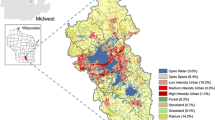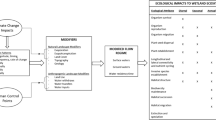Abstract
Evidence suggests that the boundaries between rivers, floodplain wetlands, and adjacent upland communities are among the most important components of landscapes. In a landscape context, floodplain wetlands and their ecotones are important transition zones between uplands and aquatic ecosystems. Management of wetland patches and ecotones to achieve sustainable ecosystems requires action on a broad scale, giving consideration to all factors affecting wetlands and the drainage basins of which they are a part. In northeastern United States, a struggle to identify new sources of water has focussed attention on the sustainability of aquatic ecosystems.
Similar content being viewed by others
References
Barbour, M. G., J. H. Burk & W. D. Pitts, 1987. Terrestrial plant ecology, 2nd edn. Benjamin-Cummings Pub. Co., Menlo Park, CA, 634 pp.
Bradley, R. S., J. K. Eischeid & P. T. Ives, 1987. The climate of Amherst, Massachusetts. Contribution No. 50. Dept. of Geology and Geography, University of Massachusetts, Amherst, MA, 108 pp.
Brower, L. P. & J. V. Z. Brower, 1971. Scientists view of the Connecticut River Basin Plan. Publication No. 1, Connecticut River Ecology Action Corporation. Hadley, MA, 24 pp.
Clements, F. E. & V. E. Shelford, 1939. Bio-ecology. John Wiley and Sons, New York, 425 pp.
Correll, D. L, 1991. Human impact on the functioning of landscape boundaries. In Holland, M. M., P. G. Risser & R. J. Naiman (eds), Ecotones: the role of landscape boundaries in the management and restoration of changing environments. Chapman and Hall, New York: 90–109.
Dawson, A., 1988. The role of the Water Supply Citizens Advisory Committee in the Long Range Water Supply Study. Massachusetts Water Resources Authority. Hadley, MA, 23 pp.
Dawson, A., 1991. Testimony on ‘An Act relative to the protection of the Metropolitan Water supply: Watershed Protection bill (House No. 2146)’. Water Supply Citizens Advisory Committee. Hadley, MA, 4 pp.
DeFalco, M. A., 1980. A history of the proposed Northfield Diversion Project. Massachusetts Steering Committee for the Connecticut River/Northfield Citizens Advisory Committee, Staff Report No. 2. Hadley, MA, 36 pp.
Eder, T. & J. Jackson, 1988. A citizen's guide to the Great Lakes Water Quality Agreement. Great Lakes United, State University of New York, Buffalo, New York, 8 pp.
Francis, G. R., J. J. Magnuson, H. A. Regier & D. R. Talhelm, 1979. Rehabilitating Great Lakes ecosystems. Great Lakes Fishery Commission Technical Report 37: 1–99.
Gregory, S. & L. Ashkenas, 1990. Riparian Management Guide for the Williamette National Forest. United States Department of Agriculture. Forest Service Publication Number 1990–591–401/35008, 120 pp.
Holland, M. M., 1974. The structure and composition of floodplain vegetation in Ned's Ditch: (M.A. thesis): Smith College, Northampton, MA, 108 pp.
Holland, M. M., 1977. Phytosociology and geological development of three abandoned meanders of the Connecticut River in western Massachusetts: (Ph.D. thesis) Univ. Mass., Five-College Cooperative Ph.D. program, Amherst, MA, 281 pp.
Holland, M. M., 1980. Update on Connecticut River Diversion project. Appalachia. 69: 124–125.
Holland, M. M. & J. Balco, 1985. Management of fresh waters: input of scientific data into policy formulation in the United States. Verh. int. Ver. Limnol. 22: 2221–2225.
Holland, M. M. & C. J. Burk, 1982. Relative ages of western Massachusetts oxbow lakes. Northeastern Geology 4: 23–32.
Holland, M. M. & C. J. Burk, 1984. The herb strata of three Connecticut River oxbow swamp forests. Rhodora 86: 397–415.
Holland, M. M. & C. J. Burk, 1990. The marsh vegetation of three Connecticut River oxbows: a ten-year comparison. Rhodora 92: 166–204.
Holland, M. M. & J. Phelps, 1988. Water resource management: changing perceptions of resource ownership in the United States. Verh. int. Ver. Limnol. 23: 1460–1464.
Holland, M. M. & R. W. Prach, 1992. Sustainability of urban wetlands. In Platt, R., editor. Proceedings from conference on Sustainable Cities. Amherst, Massachusetts (in press).
Holland, M. M., D. F. Whigham & B. Gopal, 1990. The characteristics of wetland ecotones. In R. J. Naiman & H. Decamps (eds), The ecology and management of aquaticterrestrial ecotones. Man and the Biosphere Book Series. The Parthenon Publishing Group, Carnforth, United Kingdom: 171–198.
International Joint Commission, 1988. Revised Great Lakes Water Quality Agreement of 1978, as amended by Protocol signed November 18, 1987. Consolidated by the International Joint Commission, United States and Canada, Windsor, Ontario, 84 pp.
Jackson, S. T., R. P. Futyma & D. A. Wilcox, 1988. A paleoecological test of a classical hydrosere in the Lake Michigan dunes. Ecology 69: 928–936.
Larson, J. S. & F. C. Golet, 1982. Models of freshwater wetland change in southeastern New England, In B. Gopal, R. E. Turner, R. G. Wetzel & D. F. Whigham (eds), Wetlands: ecology and management. International Scientific Publishers, Jaipur, India: 181–185.
Levin, S. A., M. A. Harwell, J. R. Kelly & K. D. Kimball, (eds), 1989. Ecotoxicology: problems and approaches. Springer-Verlag, New York, 530 pp.
Lubchenco, J., A. M. Olson, L. B. Brubaker, S. R. Carpenter, M. M. Holland, S. P. Hubbell, S. A. Levin, J. A. MacMahon, P. A. Matson, J. M. Melillo, H. A. Mooney, C. H. Peterson, H. R. Pulliam, L. A. Real, P. J. Regal & P. G. Risser, 1991. The sustainable biosphere initiative: an ecological research agenda. Ecology 72: 371–412.
Oregon Rivers Council, 1991. America's riverine ecosystems at the crossroads: a proposal for new national river system protection and restoration policies. Research Report No. X. Eugene, Oregon.
Sackett, M. H., 1979. Northfield Citizens Advisory Committee report on indicator species. Northfield Citizens Advisory Committee Staff Report No. 1, Water Supply Citizens Advisory Committee, Hadley, MA. USA.
Sackett, M. H. & J. Nagazina, 1978. Northfield Diversion Project. Appalachia Journal 42: 104–111.
Sedell, J., R. Steedman, H. Regier & S. Gregory, 1991. Restoration of human impacted land-water ecotones. In Holland, M. M., P. G. Risser & R. J. Naiman (eds), Ecotones: the role of landscape boundaries in the management and restoration of changing environments. Chapman and Hall, New York: 110–129.
Sheehan, P. J., D. R. Miller, G. C. Butler & P. Bourdeau, 1984. Effects of pollutants at the ecosystem level. John Wiley and Sons, New York, 434 pp.
Shelford, V. E., 1963. The ecology of North America. University of Illinois Press, Urbana, Illinois, 610 pp.
Sorrie, B. A., 1987. Notes on the rare flora of Massachusetts. Rhodora 89: 113–196.
Tubman, L. H., 1988. New Jersey's freshwater wetlands protection act. J. Wat. Pollut. Cont. Fed. 60: 176–179.
Turner, R. K. (ed.), 1988. Sustainable environmental management: Principles and practice. Westview, Boulder, Colorado, 292 pp.
Westman, W. E., 1985. Ecology, impact assessment, and environmental planning. Wiley-Interscience, New York, 532 pp.
World Commission on Environment and Development, 1989. Sustainable development: a guide to our common future. The Global Tomorrow Coalition, Washington, D.C., 400 pp.
Author information
Authors and Affiliations
Rights and permissions
About this article
Cite this article
Holland, M.M. Management of land/inland water ecotones: needs for regional approaches to achieve sustainable ecological systems. Hydrobiologia 251, 331–340 (1993). https://doi.org/10.1007/BF00007192
Issue Date:
DOI: https://doi.org/10.1007/BF00007192




